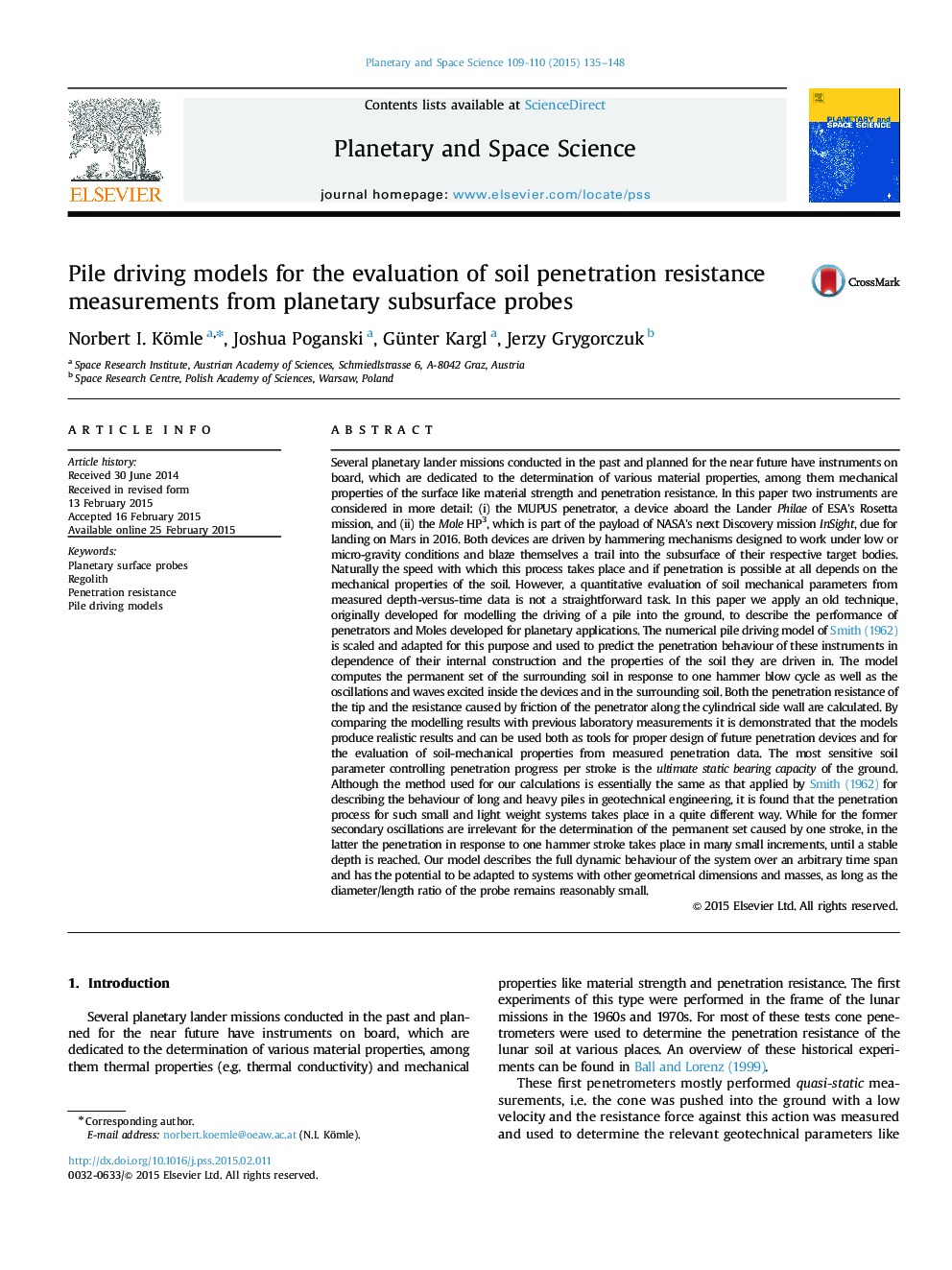| کد مقاله | کد نشریه | سال انتشار | مقاله انگلیسی | نسخه تمام متن |
|---|---|---|---|---|
| 1780975 | 1523929 | 2015 | 14 صفحه PDF | دانلود رایگان |
عنوان انگلیسی مقاله ISI
Pile driving models for the evaluation of soil penetration resistance measurements from planetary subsurface probes
ترجمه فارسی عنوان
مدل های رانش شمع برای ارزیابی اندازه گیری مقاومت نفوذ خاک از پروب های زیرسطحی سیاره ای
دانلود مقاله + سفارش ترجمه
دانلود مقاله ISI انگلیسی
رایگان برای ایرانیان
کلمات کلیدی
پروب های سطح سیاره ای، رگولیت، مقاومت نفوذ، مدل های رانندگی شمع،
موضوعات مرتبط
مهندسی و علوم پایه
علوم زمین و سیارات
فیزیک زمین (ژئو فیزیک)
چکیده انگلیسی
Several planetary lander missions conducted in the past and planned for the near future have instruments on board, which are dedicated to the determination of various material properties, among them mechanical properties of the surface like material strength and penetration resistance. In this paper two instruments are considered in more detail: (i) the MUPUS penetrator, a device aboard the Lander Philae of ESA׳s Rosetta mission, and (ii) the Mole HP3, which is part of the payload of NASA׳s next Discovery mission InSight, due for landing on Mars in 2016. Both devices are driven by hammering mechanisms designed to work under low or micro-gravity conditions and blaze themselves a trail into the subsurface of their respective target bodies. Naturally the speed with which this process takes place and if penetration is possible at all depends on the mechanical properties of the soil. However, a quantitative evaluation of soil mechanical parameters from measured depth-versus-time data is not a straightforward task. In this paper we apply an old technique, originally developed for modelling the driving of a pile into the ground, to describe the performance of penetrators and Moles developed for planetary applications. The numerical pile driving model of Smith (1962) is scaled and adapted for this purpose and used to predict the penetration behaviour of these instruments in dependence of their internal construction and the properties of the soil they are driven in. The model computes the permanent set of the surrounding soil in response to one hammer blow cycle as well as the oscillations and waves excited inside the devices and in the surrounding soil. Both the penetration resistance of the tip and the resistance caused by friction of the penetrator along the cylindrical side wall are calculated. By comparing the modelling results with previous laboratory measurements it is demonstrated that the models produce realistic results and can be used both as tools for proper design of future penetration devices and for the evaluation of soil-mechanical properties from measured penetration data. The most sensitive soil parameter controlling penetration progress per stroke is the ultimate static bearing capacity of the ground. Although the method used for our calculations is essentially the same as that applied by Smith (1962) for describing the behaviour of long and heavy piles in geotechnical engineering, it is found that the penetration process for such small and light weight systems takes place in a quite different way. While for the former secondary oscillations are irrelevant for the determination of the permanent set caused by one stroke, in the latter the penetration in response to one hammer stroke takes place in many small increments, until a stable depth is reached. Our model describes the full dynamic behaviour of the system over an arbitrary time span and has the potential to be adapted to systems with other geometrical dimensions and masses, as long as the diameter/length ratio of the probe remains reasonably small.
ناشر
Database: Elsevier - ScienceDirect (ساینس دایرکت)
Journal: Planetary and Space Science - Volumes 109â110, May 2015, Pages 135-148
Journal: Planetary and Space Science - Volumes 109â110, May 2015, Pages 135-148
نویسندگان
Norbert I. Kömle, Joshua Poganski, Günter Kargl, Jerzy Grygorczuk,
